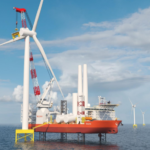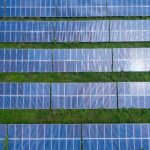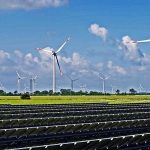Roundtable Greenlights Effort on Renewable Energy Covered Bonds
by Sean Kidney “There is more liquidity than ever being put into the system, but funds are still not being allocated to renewable energy projects” “The bottleneck for renewable energy is not in construction financing but a year or two after construction .” “ is not an asset class where risk changes over time – it changes between pre-completion to post-completion stages… it is incorrect to think that offloading an asset post-completion dumps risk onto others because the riskier part of the project is past.” “Alignment of interest with investors is strong as the issuing bank...
Eneti and Brookfield Renewable Earnings
By Tom Konrad, Ph.D. CFA
Here are a couple earnings notes I shared last week with my Patreon followers.
Eneti, Inc. (NETI) - formerly Scorpio Bulkers (SALT)
Eneti completed its name and ticker change on February 8th. New ticker is NETI (formerly Scorpio Bulkers (SALT), which I recently wrote about here.
Highlights from February 2nd earnings report:
37 of the 47 vessels owned at the 3rd quarter have been sold or have completed sale agreements.
Net asset value is $23.94/share. Since most assets are cash or vessels held for sale, this number is basically accurate.
The stock is still a good buy...
Green Asset-Backed Bond From Hannon Armstrong Has Measured GHG Savings
by the Climate Bonds Team Hannon Armstrong’s (HASI) second green ABS, $118.6m, will save 0.39 tons of GHG annually per $1,000! ($100.5m, 4.28%, 19 yr, A and $18.1m, 5.00%, 19 yr, BBB) Hannon Armstrong (NYSE:HASI) closed its second green ABS bond (Sustainable Yield Bond) following its inaugural issuance in December 2013. The ABS was a private placement split into two tranches with different credit ratings (from Kroll Bond Credit Rating Agency): $100.5m with a rating of A and 4.28% interest rate, and $18.1m with a rating of BBB and 5.00% interest rate. Both tranches have a 19-year tenor....
Solar REITs: A Better Way to Invest in Solar
Tom Konrad CFA The last day for a solar developer to submit an application for the Treasury’s 1603 grant program was September 30th, and only for grandfathered solar projects which broke ground before the end of 2011. Solar panel prices have continued to drop this year, but solar project development remains a capital-intensive business. The 1603 program allowed solar developers to monetize the solar investment tax credit (ITC) much more quickly than they could otherwise, and this essentially reduced their cost of capital. As the rush of projects begun before the end of 2011 are completed, developers are looking...
Are Aspiration’s Deposits Really Fossil Fuel Free?
Fossil Fuel Free Claims
If you are reading this, you've probably also seen advertisements for Aspriation's “Fee-free and fossil fuel free” banking services. Like the advertisements the company's product page encourages visitors to “Earn high interest on what you save with an account that is fee-free and fossil fuel free.“
As a professional green money manager, I know that “fossil fuel free” is in the eye of the beholder. For many mutual funds, “fossil fuel free” simply means avoiding the 200 largest fossil fuel companies, but investing in the 201st largest fossil fuel company, even if its primary business is mining...
One Week, Three YieldCo Deals. Are More Buyouts on the Horizon?
by Tom Konrad, Ph.D., CFA
It's been a busy several days in the YieldCo space.
On February 5, 8point3 Energy Partners (NASD:CAFD) announced an agreement to be acquired by an infrastructure investment fund managed by Capital Dynamics. While I was still writing an article on why the sale price was at a virtually unheard of discount relative to the stock market price, two more YieldCo deals were announced: NRG Energy (NYSE:NRG) agreed to sell its sponsorship stake in NRG Yield (NYSE:NYLD and NYSE:NYLD/A) to Global Infrastructure Partners, and YieldCo TerraForm Power (NASD:TERP) made an offer to buy out Spanish YieldCo Saeta Yield (Madrid:SAY) at a 20 percent...
Climate Bonds Mid-Year Roundup
by the Climate Bonds Team
Halfway in 2016: Issuance Up on 2015: New Underwriters from China: And Where Will Green Bonds Land by Dec 31st?
The Headline Figures:
At the end of Q2, issuance for 2016 stood at USD 34.6bn – bringing it close to the total issuance for 2015 with 6 months of the year to go.
In the first two weeks since the end of Q2 - total issuance surpassed the 2015 total. We expect even more in the second half of the year.
USD 18.6bn issued in Q2 alone making it the highest single quarter of green bond...
Buyer’s Guide to New York Community Solar
By Ishaan Goel
WHY COMMUNITY SOLAR?
A home solar system is a great investment, with financial returns far in excess of any financial investment that has comparable risk. It’s also a tangible step a homeowner can take to help the environment.
Unfortunately, most New Yorkers (and Americans in general) can’t install home solar. They may be renters, or have roofs that are too old or shaded. Or they may not be able to afford the up-front cost, or not have enough income to take advantage of the tax credits.
That is why New York’s electricity regulator, the Public Service Commission, created community solar:...
Climate Bond Standard to be Released This Week
Tom Konrad CFA Conserving the planet for conservative investors. Investing in clean energy stocks has an (often well-deserved) reputation for risk. Although energy efficiency and more inclusive progressive energy indexes have held up fairly well over the last few years, the performance of narrower clean energy sectors has been dismal, and some industry observers feel that the declines in wind and solar are structural (and hence permanent) as opposed to cyclical (and therefor temporary.) This presents a conundrum for investors with long time horizons who not only need their investments to earn a steady return...
Is Suzlon’s $650m Wind Bond the First of Many?
India had been trying to get a corporate bond market going for 15 years – search “growing India corporate bonds” and you’ll find papers on the subject from the Reserve Bank of India, Bank of International Settlement and others scattered over past years. The latest Indian 5 year plan has this as a priority – and has green finance as a priority in a separate section. India has a particular need: a miniscule local corporate bond market means restricted financing options for business, including for renewable and energy efficient building developers – diversity with financing options helps drive down costs...
The Green Bond Trend
DTE Energy Company (DTE: NYSE) recently priced a ‘green bond’ issuance of $525 million to support renewable energy and energy efficiency. The thirty-year bonds provide a coupon payment at 4.05%. DTE is planning to buy solar arrays and wind turbines with its newly flush cash kitty. The capital raise is of significance less for its size and purpose and more for the fact that a U.S. electric utility company is tapping this unusual financing vehicle.
True enough, green bonds are nothing new. Created to fund projects with environmental or climatic benefits, the first green bonds were issued in May 2007 by the European Investment Bank (EIB). The...
Massachusetts: Green Bond Auction Hot, Other Bonds Tepid
by Sean Kidney The Massachusetts AA+ green bond I mentioned last week got a lot of coverage on release this week – even the WSJ ran the story. But there was a twist: it seems the State had to scale back the total $1.1bn GO offering to $670m on tepid demand, but the green bond bit was 30% oversubscribed. For all you prospective issuers out there: the green bonds also lured as many as 9 new institutional investors for Massachusetts bonds. One buyer went so far as to say “We think more municipalities should do the same." So perhaps...
Developments in the Solar Corporate Bond Market
by Corporate Bonder The global bond market is huge. Data from the Bank for International Settlements shows that the total size of the global debt securities market (domestic and international securities) was $99.5 trillion as at June 2011, of which $89.9 trillion were notes and bonds. Governments accounted for $43.7 trillion of outstanding debt securities, financial organizations $43.8 trillion, corporations $11.0 trillion and international organizations $1.0 trillion. Against that, Bloomberg has estimated that there are $230bn outstanding of fixed-interest securities that meet their “green bonds” definition. And of course the IEA talks of $1 trillion of investment a...
Five Green Dividend Stocks to Watch
Tom Konrad CFA The Perfect Stock My ideal stock is: Green (in that the company is helping to make the economy more sustainable) Pays a good dividend (in the current low-interest rate environment, I consider 4% to be “good”) Has earnings and free cash flow large enough to easily sustain the dividend, and Has low debt, leading to low earnings and cash flow volatility. I like such stocks because I can buy them, and pretty much ignore them. This leaves me time to research more speculative green stocks, while still knowing that much of my portfolio is producing...
Brookfield’s Yieldco Buying Spree
by Tom Konrad Ph.D., CFA
Last week, a Bloomberg reported on a rumor that Brookfield Asset Management (BAM) was in talks to buy Abengoa's (ABGOY) stake in its former YieldCo Atlantica Yield (ABY). Atlantica had been looking for a new sponsor for well over a year since parent Abengoa filed for bankruptcy.
Purchasing Yieldcos (companies that own clean energy infrastructure and use the cash flows to pay large dividends to shareholders) is not new to Brookfield. Not only has BAM long sponsored Brookfield Renewable Partners, LP (BEP), a limited partnership that has essentially been a Yieldco since before the term was...
Funding The Energy Transition at Clean Energy Credit Union
by Tom Konrad, Ph.D., CFA
With interest rates as low as they have ever been, I believe there is little point in small investors investing in bonds or bond funds, even if an allocation to fixed income is needed to match their investments to their ability and desire to take on risk. With little potential upside from interest, I believe it is better to take advantage of the added safety of federally backed insurance by depositing money in a bank or credit union savings account or certificate of deposit (CD) ladder.
We can do that and avoid having our deposits fund...







